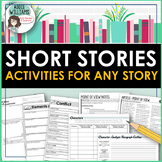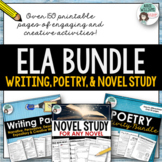Character Analysis / Study and Characterization Activity
- PDF
What educators are saying
Also included in
- Looking for a resource you can use with ANY SHORT STORY? These 4 different activities work with any short story and help students understand literary terms, characterization, plot, point of view, and more. All activities are "print and go" and the bundle includes over 40 pages. Easy to differentiaPrice $13.49Original Price $16.46Save $2.97
- NOVEL STUDY PACKAGE - Looking for resources that will work with ANY NOVEL? This bundle includes everything you need to start an independent novel study, work through a whole-class novel, or for use during Literature / Reading Circles. I use these resources to help my students analyze the plot, charPrice $14.99Original Price $18.06Save $3.07
- Over 150 pages of WRITING, NOVEL STUDY, AND POETRY RESOURCES will benefit any middle/high school ELA teacher! This bundle includes three of my top-selling ELA packs and can be used with various age groups and abilities due to the ease with which they can be differentiated! Includes 18 different aPrice $49.99Original Price $57.19Save $7.20
Description
Help your students write a character study or character analysis with this ready to use resource. Works with any novel or short story!
These worksheets are easy to differentiate for students of varying abilities and ages and lead students through the process of writing a paragraph or a full essay. A great way to dig deep into a character in a novel or short story. Uses the STEAL acronym to teach students about indirect characterization (Speech, Thoughts, Effect on other, Actions, Looks).
FOR A DIGITAL VERSION OF THIS RESOURCE - CLICK HERE!
Includes:
· STEAL Acronym Reference Sheet
· STEAL Acronym Planning page
· Character Chart for the main characters x 2
· Character Comparison Chart
· Note Taking Sheet
· Character Development
· Character Analysis Paragraph Planner— Organizer #1
· Character Analysis Paragraph Assignment
· Paragraph Outline
· Character Analysis Essay Planner—2 pages
· Essay Assignment Page
· Character Analysis Essay Outline - 3 pages
· List of Common Character Traits
PLEASE NOTE - THIS RESOURCE IS SOLD AS A NON-EDITABLE PDF.
Part of my SHORT STORY ACTIVITY BUNDLE—save money buy purchasing four short story activities together!
Click on the links below to check out my other Short Story themed items-->
Tell-Tale Heart Newspaper Assignment
Short Story Writing and Unique Story Starter Idea
Short Story Point of View Notes and Assignment
Short Story Terms Personal Dictionary
Short Story Graphic Organizers for Student Response>
Common Core Aligned
CCSS.ELA-Literacy.Reading Literature.(RL.1 and RL.3)
Addie Williams, Addie Education








